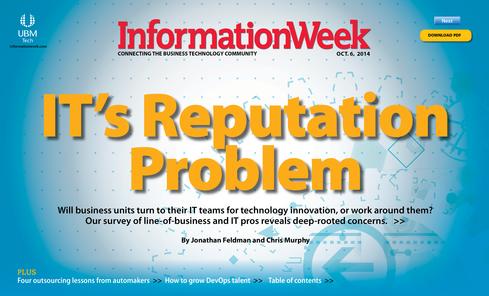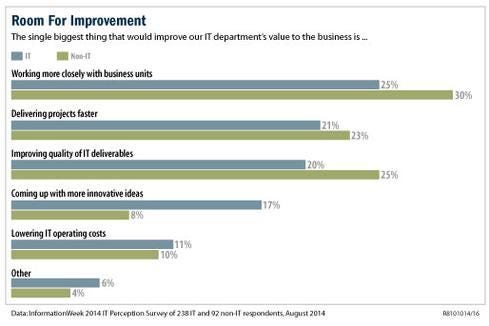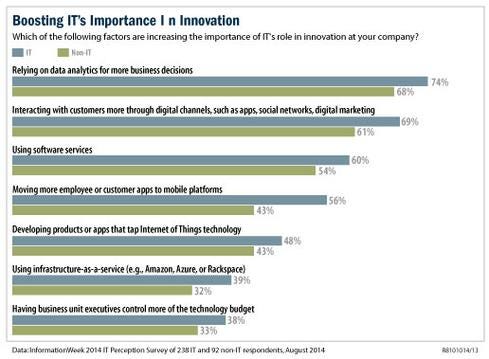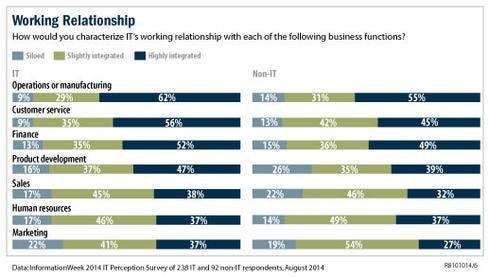How IT Can Spur Digital InnovationHow IT Can Spur Digital Innovation
Digital initiatives are where the action is. These 3 companies show how IT can get involved before there's a breakdown or breach.

 Download the entire new issue of information Tech Digest, distributed in an all-digital format.
Download the entire new issue of information Tech Digest, distributed in an all-digital format.
An Esurance customer who gets in a fender bender can fire up a smartphone app, let the call center rep see the damage through real-time video using the phone's camera, and use the same app to talk with the rep and file a claim. Esurance's goal is to process claims faster and make it easier on the customer.
As I talk with Esurance software development VP Phil Rodoni about how the company came up with the idea for this video app, he glosses right over one of the most important steps. Rodoni explains that Joe Laurentino, VP of material damage, uses Apple's FaceTime with his family and wondered if real-time video could help Esurance speed up claims processing. So Laurentino called Rodoni's development team, which led to a bunch of developers having lunch and sketching out which features people might want and the technology that would make it possible.
Right there, that's it. Do you even see that moment, Phil? A person working in claims had a bright idea about using tech, and Step 1 was to call the IT team and ask: "Whaddya think?" That's not how it works at all companies, Phil. In our recent IT Perception Survey, 72% of the 238 IT pros who responded said they "completely agree" that IT should work closely with business unit execs to develop innovative apps. But just 54% of the 92 non-IT pros who responded said they feel that strongly, with the rest mostly in the "somewhat agree" or neutral category. That's 18 points of separation on how IT fits into the innovation picture.
Figure 1: 
Customer-facing mobile apps. New products embedded with technology. Analytics-driven marketing programs. Fast-moving, customer-facing digital initiatives like those and Esurance's video appraisal are where the action and prestige are for technologists. Yet IT too often gets the call only when something breaks or is breached.
I asked Rodoni about that call from Laurentino, and he says that's just how things work at Esurance. IT people are embedded in business units, including the claims group. But as a company built from scratch as an online insurance company (now owned by Allstate), it's also just part of the culture that IT is integral to most every project. "If someone has an idea technology-wise, I can't think of a case where they didn't pick up the phone," Rodoni says. "That's not to say we do all things in house, but they usually ask us, 'Hey, can we do this?' and they think of us as the general contractor in terms of how we can go get this thing built."
[Can IT teams deliver the innovation companies need? Read IT Has A Reputation Problem.]
As we talked about the video appraisal project, I heard a couple of other factors that must contribute to Esurance's IT folks getting called in early to digital business projects.
One is the need for speed. In six weeks, IT had a prototype in colleagues' hands. The app was in front of customers in about four months, Rodoni says. Often the reason business units veer around the IT organization is the fear that in-house IT can't deliver fast enough.
The other is hands-on teamwork. Esurance developers went from the San Francisco IT office to the Dallas office, where customer-support agents work, to see how the app would fit into their colleagues' workday. Little things matter, like testing headsets until they found the one that works best. IT shipped devices loaded with the app to field appraisers nationwide so they could test the app in the parking lots and back roads that customers would call from. Field testing taught some vital lessons, such as how much bandwidth customers would need -- how many bars on their smartphones -- to even start a video session.
Sure, it's easy for a born-on-the-web company to live and breathe such digital innovation, right? But what about La Quinta Inns & Suites, a 46-year-old hotel chain that outsources all of its app development? Or Insurance Auto Auctions, which does the gritty work of auctioning off totaled cars for insurance companies? information recognized all three companies as innovators on this year's information Elite 100 ranking. Here's how La Quinta and IAA are also driving digital innovation, and the role that IT plays in that journey.
"In the loop" isn't collaboration
Although La Quinta outsources all of its app dev, its IT team still partnered with the marketing team on a mobile initiative that made it easier for customers to book hotel reservations.
La Quinta CIO Vivek Shaiva describes how the company's marketing and IT pros listened in together on customer focus groups. They took that feedback, started brainstorming innovative new ideas, and "somewhere in that process, we came up with this idea of Instant Hold," Shaiva says.
Instant Hold is La Quinta's answer to how annoying it is to type in a 16-digit credit card number plus expiration date onto a little smartphone screen in order to make a reservation. Started last year, Instant Hold lets customers hold a room for four hours using their mobile phone number, until they can arrive in person, call, or get to a PC to book with a credit card number. (La Quinta has applied for a patent on the function.)
Did marketing really need IT's involvement? Or could it have cooked up that idea by itself, and then hired an outside mobile development team to code it? Yes, in theory, it could have. But Instant Hold creates a ripple effect. Local hotel managers must know if a room is being held, so that they don't give it away, and that means the new interface had to be integrated with the company's property management system for its 848 hotels. La Quinta also must watch for abuse, like someone holding 20 rooms with one number. And so on. "Multiply anything by 800 hotels, and it's not an easy job to deploy these technologies," Shaiva says.
IT must be known as the indispensable partner for scale, integration, security, and performance of any digital initiative. Ideally, IT must build a reputation for great vendor and project management, and for user
interface design and customer experience. La Quinta outsources the application development, but Shaiva's IT group brings the discipline and methodology to the effort. Developers did the coding in three-day sprint sessions, each with marketing pros in the room to answer questions.
Figure 2: 
At each of five key project stages, the stakeholders stop to have what Shaiva calls 30-minute "tollgate" meetings, in which the business unit and IT teams go over where they're at and where they're headed. Anyone can throw up a red light -- if costs are running higher than expected, for example, or if the technology isn't cutting it. Teams have up to 48 hours to fix what led to the red light. About 5% of projects get killed at one of these tollgates, which come at what Shaiva describes as the strategy, architecture, design, build, and pre-production stages. Most projects that get killed are stopped at the strategy stage, and on occasion at the architecture stage. "We don't want cowboy development," Shaiva says. "... It's our own flavor of Agile scrum."
For example, for a recent website redesign, La Qunta implemented two-week design and development sprints that included three days of joint design, configuration, and coding sessions, where marketing teams were in the room as part of the process. It used a similar Agile process for the design of Instant Hold.
The IT-marketing relationship is among the weakest at companies, our survey finds. Just 37% of IT pros say they're highly integrated with their marketing colleagues, a percentage that's lower than with all six other functions we asked about. The non-IT pros in our survey think even less of this relationship: Just 27% say IT and marketing are highly integrated at their companies. "Keeping each other in the loop isn't collaborating," warns Shaiva.
A CEO's view of digital innovation
Insurance Auto Auctions holds live auctions at over 165 sites across North America, but buyers come from 110 countries worldwide thanks to live-streaming via web and mobile apps that offer real-time bidding and translations into six languages. PC and tablet apps let buyers monitor and bid on as many as eight live auctions at the same time, while a smartphone app lets them bid on one at a time.
Even live auction attendees are glued to their devices, viewing some of the more than 15 million vehicle photos IAA posts a year. "They're at the physical auction raising their one hand, and in the other hand they have their mobile phone and they're bidding on vehicles in another auction somewhere else," says CEO John Kett. "That's honestly something we didn't think about. We thought of them almost as discrete, but really they're using them at the same time."
IAA is living one lesson of digital business: People don't want to unplug; they expect you to make their in-person experience even better via a mobile device. IAA is adapting techniques from B2C e-commerce, such as a new project to improve vehicle image quality and let buyers zoom in to look at a car's damage more closely.
When I spoke with Kett and IAA CTO John Krupnik, they didn't talk about "aligning" IT efforts with business priorities. With tech so central to operations, Kett described sitting down with Krupnik, and the company's operations, finance, and marketing leaders to map business priorities. "John's not alone," says Kett, about his CTO balancing priorities. "... We're very much tuned into what constraints or roadblocks [IT] might have, and we help him manage through that, because ultimately we own it."
Krupnik makes sure his technologists have just as tight a connection to business priorities and challenges.
IAA's key customers, besides car buyers, are insurance companies. When insurers take in totaled vehicles, they turn to IAA to get the title and sell them as quickly as possible. When a disaster such as a hurricane or flood hits somewhere in the US, there's a surge of totaled cars in that area that need processing, overwhelming local teams. So Krupnik will send his IT team out to the field to process cars, at a time when IAA's technology is under the most intense pressure to perform.
"Normally, they don't get to see their technology directly in the hands of that user," Krupnik says. "And the stories that they share, it's amazing. There's a level of personal satisfaction with that, too, where they can really connect the dots of how they started with that requirement." IAA has an innovation team, but it's not a part of the IT organization; there aren't even IT pros on it. Kett intentionally staffed that group with people from disciplines other than tech, and from other companies and industries, to get a fresh perspective on how IAA should be using emerging technology.
Our survey suggests that few companies look to IT as the main innovation engine. When we asked which of seven factors will increase IT's importance in innovation, more than 60% of non-IT and IT did cite two factors: relying more on data analytics for business decisions, and interacting more with customers through digital channels. However, just 8% of non-IT leaders say "more innovative ideas" is the No. 1 area of improvement they need from IT.
Figure 3: 
Instead, the top three responses (covering more than three-fourths of survey respondents) on ways to improve IT are to work more closely with business units, deliver projects faster, and improve IT quality. Just 11% cite lowering IT costs.
Translation: Work with us to get stuff done, and we can figure out a way to pay for it. "If there's ROI, the money can be found," La Quinta CIO Shaiva says. "It's the ability to execute" a project in partnership with the business that matters.
Read the rest of the story in the new issue of
information Tech Digest.
About the Author
You May Also Like






